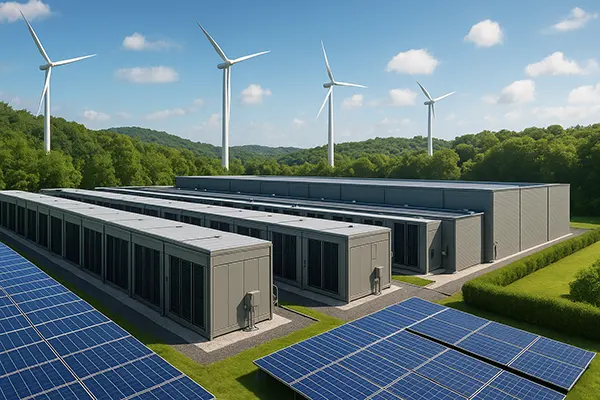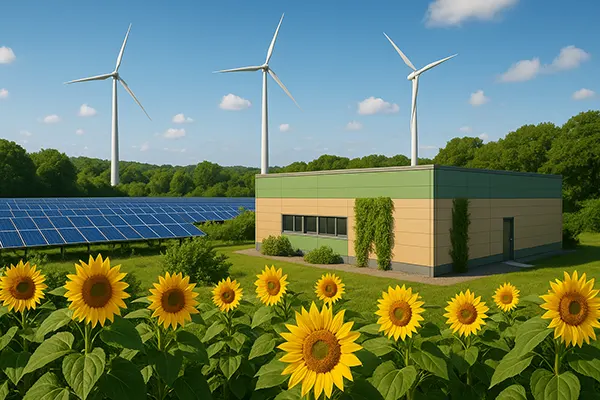
Green Data Centres: The Future of Europe’s Digital Infrastructure
With Europe rapidly accelerating its digital ambitions, the conversation around sustainability is becoming increasingly central. Green data centres are not only a response to climate concerns but also a fundamental step towards building resilient, energy-efficient digital infrastructures. As environmental regulations tighten and energy prices rise, Europe’s path forward clearly favours low-emission and renewable-powered data centres.
Renewable Energy Integration in European Data Centres
By 2025, a significant portion of European data centres are expected to run on renewable energy sources. Countries like Denmark, the Netherlands, and Sweden lead this transition with favourable regulations, infrastructure incentives, and direct access to wind, hydro, and solar energy. The European Green Deal plays a pivotal role in aligning digital and environmental goals, pushing for carbon-neutral data services by 2030.
Large tech firms are already setting the tone. Microsoft’s data centre in Sweden runs on 100% renewable energy and uses sustainable cooling techniques. Google and AWS are also investing in green facilities across the continent, with long-term Power Purchase Agreements (PPAs) supporting new wind and solar farms in Ireland, Spain, and Germany.
Beyond sourcing clean energy, smart grid technologies are becoming essential. These systems allow data centres to dynamically balance load demands and integrate surplus energy into national grids, improving both resilience and sustainability.
Challenges in Renewable Transition
Despite progress, not all regions in Europe are equally positioned. Southern and Eastern European countries often lack the robust renewable infrastructure needed to power green data centres efficiently. This creates a disparity in adoption and requires cross-border cooperation and EU-level funding support.
Intermittency remains another challenge. Solar and wind power are not always available at full capacity, requiring effective energy storage solutions. Although battery technology is improving, the costs and environmental impact of large-scale installations still pose issues.
Finally, regulatory differences between countries can slow down the standardisation of green practices across Europe. A unified regulatory framework, possibly under the EU’s Digital Europe Programme, is needed to harmonise efforts and accelerate adoption across member states.
Energy Efficiency Innovations in Modern Data Centres
European data centres are leading the way in innovating energy-efficient technologies. From advanced liquid cooling systems to artificial intelligence (AI)-driven energy optimisation, new tools are reshaping how facilities manage their power consumption. These technologies are not only cost-effective but also drastically reduce greenhouse gas emissions.
AI-powered systems can predict peak usage times and adjust cooling, lighting, and compute workloads accordingly. According to a 2024 study by the Uptime Institute, such systems can cut energy use by up to 30%, making them a vital part of green transformation.
Another growing practice is server virtualisation and edge computing. By optimising server loads and decentralising data processing, these methods significantly reduce energy consumption and latency, especially important for real-time applications like autonomous driving and industrial automation.
Adoption Barriers and Economic Impacts
High upfront costs remain the main barrier to adopting these energy-efficient solutions, particularly for small and medium-sized data centre operators. While long-term savings are clear, initial investment often requires government subsidies or private sector financing support.
However, the economic incentives are growing. Green data centres attract tech investments, create high-skilled jobs, and enhance regional competitiveness. Cities with green infrastructure become attractive hubs for digital industries, bolstering local economies.
Tax incentives, green financing instruments, and EU-level grants are starting to bridge the cost gap. In 2025, the European Investment Bank (EIB) increased funding for energy-efficient data centre projects, with a focus on underdeveloped regions in Southern Europe.

Regulatory Landscape and Strategic Outlook
The regulatory framework is evolving rapidly. The European Commission’s “EU Code of Conduct for Data Centres” sets voluntary best practices, but recent discussions aim to move towards binding standards. Future policies will likely include mandatory energy audits, sustainability disclosures, and incentives for carbon-negative operations.
The EU Data Act and Digital Services Act (DSA) also influence how data centres handle storage and transmission, indirectly pushing for more efficient infrastructure. These regulations, along with upcoming ESG requirements, make green transformation not only an environmental necessity but also a legal and commercial imperative.
Strategically, the move to green data centres supports Europe’s digital sovereignty. By developing local, sustainable digital infrastructure, the EU reduces dependence on non-European data services and strengthens cybersecurity resilience.
Long-Term Vision and Global Influence
Europe aims to set a global example by proving that digital growth and sustainability can go hand in hand. By 2030, the EU targets having all major data centres carbon-neutral and powered entirely by renewables. This ambition aligns with the UN’s Sustainable Development Goals and positions Europe as a green tech leader.
Partnerships with Asia and North America are also evolving. Joint R&D projects, especially in areas like green hydrogen for backup power, aim to accelerate innovation on a global scale. The EU’s Horizon Europe programme is one key driver of this collaboration.
Ultimately, green data centres are not just a trend — they are the future. With environmental urgency, technological innovation, and regulatory pressure converging, Europe’s digital infrastructure is undergoing a profound, sustainable transformation.